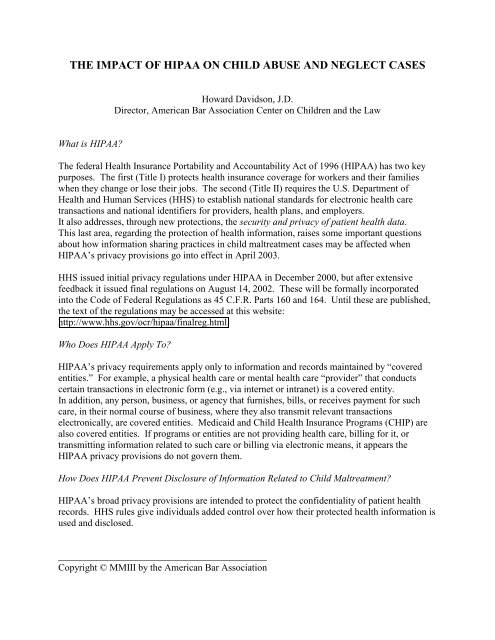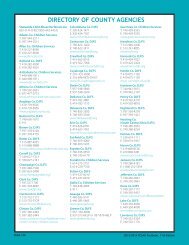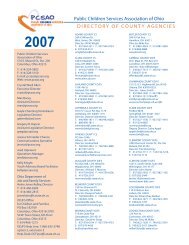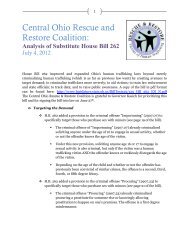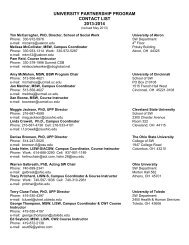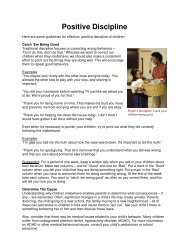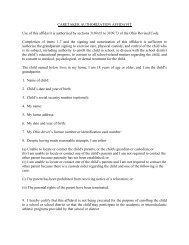The Impact of HIPAA on Child Abuse and Neglect Cases
The Impact of HIPAA on Child Abuse and Neglect Cases
The Impact of HIPAA on Child Abuse and Neglect Cases
Create successful ePaper yourself
Turn your PDF publications into a flip-book with our unique Google optimized e-Paper software.
THE IMPACT OF <str<strong>on</strong>g>HIPAA</str<strong>on</strong>g> ON CHILD ABUSE AND NEGLECT CASES<br />
Howard Davids<strong>on</strong>, J.D.<br />
Director, American Bar Associati<strong>on</strong> Center <strong>on</strong> <strong>Child</strong>ren <strong>and</strong> the Law<br />
What is <str<strong>on</strong>g>HIPAA</str<strong>on</strong>g>?<br />
<str<strong>on</strong>g>The</str<strong>on</strong>g> federal Health Insurance Portability <strong>and</strong> Accountability Act <str<strong>on</strong>g>of</str<strong>on</strong>g> 1996 (<str<strong>on</strong>g>HIPAA</str<strong>on</strong>g>) has two key<br />
purposes. <str<strong>on</strong>g>The</str<strong>on</strong>g> first (Title I) protects health insurance coverage for workers <strong>and</strong> their families<br />
when they change or lose their jobs. <str<strong>on</strong>g>The</str<strong>on</strong>g> sec<strong>on</strong>d (Title II) requires the U.S. Department <str<strong>on</strong>g>of</str<strong>on</strong>g><br />
Health <strong>and</strong> Human Services (HHS) to establish nati<strong>on</strong>al st<strong>and</strong>ards for electr<strong>on</strong>ic health care<br />
transacti<strong>on</strong>s <strong>and</strong> nati<strong>on</strong>al identifiers for providers, health plans, <strong>and</strong> employers.<br />
It also addresses, through new protecti<strong>on</strong>s, the security <strong>and</strong> privacy <str<strong>on</strong>g>of</str<strong>on</strong>g> patient health data.<br />
This last area, regarding the protecti<strong>on</strong> <str<strong>on</strong>g>of</str<strong>on</strong>g> health informati<strong>on</strong>, raises some important questi<strong>on</strong>s<br />
about how informati<strong>on</strong> sharing practices in child maltreatment cases may be affected when<br />
<str<strong>on</strong>g>HIPAA</str<strong>on</strong>g>’s privacy provisi<strong>on</strong>s go into effect in April 2003.<br />
HHS issued initial privacy regulati<strong>on</strong>s under <str<strong>on</strong>g>HIPAA</str<strong>on</strong>g> in December 2000, but after extensive<br />
feedback it issued final regulati<strong>on</strong>s <strong>on</strong> August 14, 2002. <str<strong>on</strong>g>The</str<strong>on</strong>g>se will be formally incorporated<br />
into the Code <str<strong>on</strong>g>of</str<strong>on</strong>g> Federal Regulati<strong>on</strong>s as 45 C.F.R. Parts 160 <strong>and</strong> 164. Until these are published,<br />
the text <str<strong>on</strong>g>of</str<strong>on</strong>g> the regulati<strong>on</strong>s may be accessed at this website:<br />
http://www.hhs.gov/ocr/hipaa/finalreg.html.<br />
Who Does <str<strong>on</strong>g>HIPAA</str<strong>on</strong>g> Apply To?<br />
<str<strong>on</strong>g>HIPAA</str<strong>on</strong>g>’s privacy requirements apply <strong>on</strong>ly to informati<strong>on</strong> <strong>and</strong> records maintained by “covered<br />
entities.” For example, a physical health care or mental health care “provider” that c<strong>on</strong>ducts<br />
certain transacti<strong>on</strong>s in electr<strong>on</strong>ic form (e.g., via internet or intranet) is a covered entity.<br />
In additi<strong>on</strong>, any pers<strong>on</strong>, business, or agency that furnishes, bills, or receives payment for such<br />
care, in their normal course <str<strong>on</strong>g>of</str<strong>on</strong>g> business, where they also transmit relevant transacti<strong>on</strong>s<br />
electr<strong>on</strong>ically, are covered entities. Medicaid <strong>and</strong> <strong>Child</strong> Health Insurance Programs (CHIP) are<br />
also covered entities. If programs or entities are not providing health care, billing for it, or<br />
transmitting informati<strong>on</strong> related to such care or billing via electr<strong>on</strong>ic means, it appears the<br />
<str<strong>on</strong>g>HIPAA</str<strong>on</strong>g> privacy provisi<strong>on</strong>s do not govern them.<br />
How Does <str<strong>on</strong>g>HIPAA</str<strong>on</strong>g> Prevent Disclosure <str<strong>on</strong>g>of</str<strong>on</strong>g> Informati<strong>on</strong> Related to <strong>Child</strong> Maltreatment?<br />
<str<strong>on</strong>g>HIPAA</str<strong>on</strong>g>’s broad privacy provisi<strong>on</strong>s are intended to protect the c<strong>on</strong>fidentiality <str<strong>on</strong>g>of</str<strong>on</strong>g> patient health<br />
records. HHS rules give individuals added c<strong>on</strong>trol over how their protected health informati<strong>on</strong> is<br />
used <strong>and</strong> disclosed.<br />
___________________________________________<br />
Copyright © MMIII by the American Bar Associati<strong>on</strong>
2<br />
<str<strong>on</strong>g>HIPAA</str<strong>on</strong>g> requires that covered entities give patients written notice <str<strong>on</strong>g>of</str<strong>on</strong>g> their privacy rights. Under<br />
most circumstances, patients must give specific authorizati<strong>on</strong> before covered entities can share<br />
their informati<strong>on</strong> or records. A general, but limited, excepti<strong>on</strong> is what the rules call “routine”<br />
situati<strong>on</strong>s, such as comm<strong>on</strong> sign-in lists used in doctors’ <str<strong>on</strong>g>of</str<strong>on</strong>g>fice recepti<strong>on</strong> areas to note arrivals <str<strong>on</strong>g>of</str<strong>on</strong>g><br />
each patient.<br />
<str<strong>on</strong>g>HIPAA</str<strong>on</strong>g>’s privacy protecti<strong>on</strong>s will have important implicati<strong>on</strong>s for child protective services<br />
agencies, other entities involved in child welfare work, <strong>and</strong> advocates when they seek − in child<br />
maltreatment cases − records or informati<strong>on</strong> <strong>on</strong> adults or children from “covered” hospitals,<br />
clinics, physicians, psychologists, psychiatrists, etc. As explained below, HHS has provided<br />
excepti<strong>on</strong>s to make clear that health care providers suspecting child maltreatment still must<br />
report it. <str<strong>on</strong>g>The</str<strong>on</strong>g> excepti<strong>on</strong>s, however, more clearly exempt disclosure <str<strong>on</strong>g>of</str<strong>on</strong>g> certain child victim<br />
records than they do physical or mental health informati<strong>on</strong> pertaining to perpetrators <str<strong>on</strong>g>of</str<strong>on</strong>g> child<br />
maltreatment, parents <str<strong>on</strong>g>of</str<strong>on</strong>g> child maltreatment victims generally, other adults or children in the<br />
child’s home, or prospective adult caretakers (e.g., foster or kinship care providers). <str<strong>on</strong>g>The</str<strong>on</strong>g>refore,<br />
it is important that those seeking health informati<strong>on</strong> <strong>on</strong> such adults for child safety-related<br />
purposes become familiar with <str<strong>on</strong>g>HIPAA</str<strong>on</strong>g> privacy protecti<strong>on</strong>s generally, as well as the scope <str<strong>on</strong>g>of</str<strong>on</strong>g> the<br />
excepti<strong>on</strong>s. Further clarificati<strong>on</strong> <strong>on</strong> these issues will undoubtedly be needed from HHS.<br />
What <str<strong>on</strong>g>HIPAA</str<strong>on</strong>g> Excepti<strong>on</strong>s Apply to <strong>Child</strong> Maltreatment?<br />
Disclosure <str<strong>on</strong>g>of</str<strong>on</strong>g> child abuse/neglect related informati<strong>on</strong> is addressed in three secti<strong>on</strong>s <str<strong>on</strong>g>of</str<strong>on</strong>g> the <str<strong>on</strong>g>HIPAA</str<strong>on</strong>g><br />
regulati<strong>on</strong>s-- Secti<strong>on</strong>s 160.203, 164.502(g)(5), <strong>and</strong> 164.512.<br />
(1) Secti<strong>on</strong> 160.203 sets forth a series <str<strong>on</strong>g>of</str<strong>on</strong>g> excepti<strong>on</strong>s to general <str<strong>on</strong>g>HIPAA</str<strong>on</strong>g> privacy requirements. It<br />
also clarifies that <str<strong>on</strong>g>HIPAA</str<strong>on</strong>g> generally overrides state laws where they are c<strong>on</strong>trary to <str<strong>on</strong>g>HIPAA</str<strong>on</strong>g>.<br />
160.203(c) says that <str<strong>on</strong>g>HIPAA</str<strong>on</strong>g> rules do not apply where the “provisi<strong>on</strong> <str<strong>on</strong>g>of</str<strong>on</strong>g> State law, including<br />
State procedures established under such law, as applicable, provides for the reporting <str<strong>on</strong>g>of</str<strong>on</strong>g> disease<br />
or injury, child abuse, birth, or death, or for the c<strong>on</strong>duct <str<strong>on</strong>g>of</str<strong>on</strong>g> public health surveillance,<br />
investigati<strong>on</strong>, or interventi<strong>on</strong>.” This might be c<strong>on</strong>strued to permit, assuming relevant<br />
authorizati<strong>on</strong> in State legislati<strong>on</strong>, the sharing <str<strong>on</strong>g>of</str<strong>on</strong>g> both health records <strong>and</strong> informati<strong>on</strong> c<strong>on</strong>cerning<br />
adults <strong>and</strong> children, since this broadly worded excepti<strong>on</strong> to <str<strong>on</strong>g>HIPAA</str<strong>on</strong>g>’s privacy protecti<strong>on</strong>s not<br />
<strong>on</strong>ly permits “reporting” but also appears to permit disclosure <str<strong>on</strong>g>of</str<strong>on</strong>g> public health-related case<br />
informati<strong>on</strong> <strong>on</strong> child maltreatment <strong>and</strong> child fatalities to those c<strong>on</strong>ducting activities related to<br />
“investigati<strong>on</strong>” <strong>and</strong> “interventi<strong>on</strong>” in such cases.<br />
Although not generally thought <str<strong>on</strong>g>of</str<strong>on</strong>g> as public health related functi<strong>on</strong>s, investigative <strong>and</strong><br />
interventi<strong>on</strong> resp<strong>on</strong>ses to child maltreatment clearly are public health matters, even if<br />
government social services or law enforcement agencies play the lead roles. Thus, disclosures <str<strong>on</strong>g>of</str<strong>on</strong>g><br />
health informati<strong>on</strong> to multidisciplinary teams, children’s advocacy centers, <strong>and</strong> child fatality<br />
review groups − about relevant children <strong>and</strong> adults − could fall within this excepti<strong>on</strong> to <str<strong>on</strong>g>HIPAA</str<strong>on</strong>g><br />
privacy requirements.
3<br />
Additi<strong>on</strong>ally, “reporting” <str<strong>on</strong>g>of</str<strong>on</strong>g> child maltreatment may not necessarily be limited to what the<br />
reporter says when calling in a report. In many states, reporting laws also require m<strong>and</strong>atory<br />
reporters to submit a written report <strong>and</strong> to answer questi<strong>on</strong>s c<strong>on</strong>cerning facts related to the matter<br />
that they reported.<br />
(2) Secti<strong>on</strong> 164.502(g)(5) addresses situati<strong>on</strong>s where a “pers<strong>on</strong>al representative” <str<strong>on</strong>g>of</str<strong>on</strong>g> an individual<br />
entitled to <str<strong>on</strong>g>HIPAA</str<strong>on</strong>g> protecti<strong>on</strong>s (e.g., a parent <str<strong>on</strong>g>of</str<strong>on</strong>g> a child patient) need not be provided access <strong>and</strong><br />
c<strong>on</strong>trol over the individual’s records. Such situati<strong>on</strong>s exist when there is a “reas<strong>on</strong>able belief”<br />
that the individual “has been or may be subjected to domestic violence, abuse, or neglect by such<br />
pers<strong>on</strong>” or where treating that pers<strong>on</strong> as the pers<strong>on</strong>al representative “could endanger the<br />
individual.” Before restricting such access <strong>and</strong> c<strong>on</strong>trol, there must be a pr<str<strong>on</strong>g>of</str<strong>on</strong>g>essi<strong>on</strong>al judgment<br />
that “it is not in the best interest <str<strong>on</strong>g>of</str<strong>on</strong>g> the individual to treat the pers<strong>on</strong> as the individual’s pers<strong>on</strong>al<br />
representative.” <str<strong>on</strong>g>The</str<strong>on</strong>g>se are important provisi<strong>on</strong>s that can help keep a maltreated child’s medical<br />
informati<strong>on</strong> out <str<strong>on</strong>g>of</str<strong>on</strong>g> the h<strong>and</strong>s <str<strong>on</strong>g>of</str<strong>on</strong>g> an abusive parent.<br />
(3) Secti<strong>on</strong> 164.512 addresses a range <str<strong>on</strong>g>of</str<strong>on</strong>g> situati<strong>on</strong>s where a patient’s authorizati<strong>on</strong> or<br />
opportunity to agree or object to the release <str<strong>on</strong>g>of</str<strong>on</strong>g> informati<strong>on</strong> (i.e., the subject’s c<strong>on</strong>sent) may not<br />
be required.<br />
164.512(a) provides excepti<strong>on</strong>s when uses <strong>and</strong> disclosures <str<strong>on</strong>g>of</str<strong>on</strong>g> informati<strong>on</strong> are “required by law.”<br />
164.512(b)(1) permits disclosure <str<strong>on</strong>g>of</str<strong>on</strong>g> informati<strong>on</strong> for “public health activities” which include<br />
preventi<strong>on</strong> <str<strong>on</strong>g>of</str<strong>on</strong>g> injuries as well as disclosures to an “appropriate government authority authorized<br />
by law to receive reports <str<strong>on</strong>g>of</str<strong>on</strong>g> child abuse or neglect.”<br />
164.512(c) addresses informati<strong>on</strong> <strong>on</strong> victims, <strong>and</strong> permits disclosure <str<strong>on</strong>g>of</str<strong>on</strong>g> informati<strong>on</strong> (bey<strong>on</strong>d<br />
mere reporting) about victims <str<strong>on</strong>g>of</str<strong>on</strong>g> child maltreatment or domestic violence, even if otherwise<br />
“protected health informati<strong>on</strong>,” to appropriate government authorities <strong>on</strong>ly if:<br />
1) Such disclosure would be authorized or required by law or regulati<strong>on</strong>s; <strong>and</strong><br />
2) Disclosure <str<strong>on</strong>g>of</str<strong>on</strong>g> informati<strong>on</strong> <strong>on</strong> the victim is c<strong>on</strong>sidered necessary to prevent serious<br />
harm to them or to other potential victims; or<br />
3) <str<strong>on</strong>g>The</str<strong>on</strong>g> victim c<strong>on</strong>sents to the disclosure.<br />
When the victim cannot c<strong>on</strong>sent due to incapacity, the agency receiving the child maltreatment<br />
report must indicate that disclosed informati<strong>on</strong> is “not intended to be used against” the victim<br />
<strong>and</strong> that acti<strong>on</strong>s delaying interventi<strong>on</strong>s until the victim could c<strong>on</strong>sent to disclosure would<br />
“materially <strong>and</strong> adversely” affect those interventi<strong>on</strong>s. Moreover, victims must be orally notified<br />
<str<strong>on</strong>g>of</str<strong>on</strong>g> disclosures <str<strong>on</strong>g>of</str<strong>on</strong>g> informati<strong>on</strong> unless notice would place them at risk <str<strong>on</strong>g>of</str<strong>on</strong>g> serious harm or would be<br />
given to a pers<strong>on</strong> (e.g., the victim’s parent) resp<strong>on</strong>sible for the abuse or neglect, <strong>and</strong> thus<br />
informing them would not be in the child victim’s best interests.<br />
(Note that the above three provisi<strong>on</strong>s in Secti<strong>on</strong> 164.512(c) address disclosure <str<strong>on</strong>g>of</str<strong>on</strong>g> informati<strong>on</strong><br />
relating to the “victim” <strong>on</strong>ly, <strong>and</strong> not <strong>on</strong> the alleged “perpetrator” <str<strong>on</strong>g>of</str<strong>on</strong>g> abuse or any other adults<br />
or children.)
4<br />
164.512(d) provides an excepti<strong>on</strong> for “health oversight activities.” <str<strong>on</strong>g>The</str<strong>on</strong>g>se do not cover situati<strong>on</strong>s<br />
where the individual about whom disclosures relate is the subject <str<strong>on</strong>g>of</str<strong>on</strong>g> an investigati<strong>on</strong> or activity.<br />
It is not clear how this provisi<strong>on</strong> might be c<strong>on</strong>strued to affect access to health informati<strong>on</strong> by<br />
child protective services agencies, child fatality review teams, or others.<br />
164.512(e) permits disclosures made pursuant to court or administrative orders, or by subpoena,<br />
discovery, or other legal process. It also requires that the individual receive notice <strong>and</strong> an<br />
opportunity to object to disclosure, <strong>and</strong> it provides for a “qualified protective order” process to<br />
restrict use <str<strong>on</strong>g>of</str<strong>on</strong>g> informati<strong>on</strong> to the litigati<strong>on</strong> itself. This excepti<strong>on</strong> could also be applied to court<br />
orders in the investigative stage <str<strong>on</strong>g>of</str<strong>on</strong>g> child maltreatment cases, as well as to court orders issued<br />
after a petiti<strong>on</strong> alleging child maltreatment has been filed.<br />
164.512(f) provides an excepti<strong>on</strong> for inquiries made by law enforcement agencies. <str<strong>on</strong>g>The</str<strong>on</strong>g>re are<br />
some limitati<strong>on</strong>s <strong>on</strong> what informati<strong>on</strong> can be released to police. When informati<strong>on</strong> is sought<br />
about child victims <str<strong>on</strong>g>of</str<strong>on</strong>g> crime, provisi<strong>on</strong>s for disclosure to police are similar to those in Secti<strong>on</strong><br />
164.512(c). Since child protective services agencies are not c<strong>on</strong>sidered part <str<strong>on</strong>g>of</str<strong>on</strong>g> “law<br />
enforcement,” this provisi<strong>on</strong> probably does not apply to those agencies.<br />
164.512(g) provides an excepti<strong>on</strong> for disclosing informati<strong>on</strong> to cor<strong>on</strong>ers or medical examiners<br />
(<strong>and</strong> for entities that perform such duties). It is an important provisi<strong>on</strong> affecting access to<br />
informati<strong>on</strong> for determining whether a child has died as a result <str<strong>on</strong>g>of</str<strong>on</strong>g> abuse or neglect.<br />
164.512(i) provides an excepti<strong>on</strong> for research purposes, which would include research related to<br />
child maltreatment cases. Disclosures for research purposes must be reviewed <strong>and</strong> approved by<br />
an instituti<strong>on</strong>al review or privacy board.<br />
164.512(j) includes a broadly worded excepti<strong>on</strong> for disclosures “to avert a serious threat to<br />
health or safety.” Covered entities may disclose informati<strong>on</strong>, c<strong>on</strong>sistent with legal <strong>and</strong> ethical<br />
st<strong>and</strong>ards, when necessary “to prevent or lessen a serious <strong>and</strong> imminent threat to the health or<br />
safety <str<strong>on</strong>g>of</str<strong>on</strong>g> a pers<strong>on</strong> or the public” when the disclosure is to those who can help prevent or lessen<br />
the threat. This is c<strong>on</strong>sistent with the “duty to warn” principal stated in Taras<str<strong>on</strong>g>of</str<strong>on</strong>g>f v. Regents <str<strong>on</strong>g>of</str<strong>on</strong>g><br />
the University <str<strong>on</strong>g>of</str<strong>on</strong>g> California, 551 P.2d 334 (1976).<br />
This secti<strong>on</strong> also establishes or reinforces a type <str<strong>on</strong>g>of</str<strong>on</strong>g> “privileged communicati<strong>on</strong>” by providing<br />
that an admissi<strong>on</strong> by a pers<strong>on</strong> that they have committed a violent crime cannot be disclosed to<br />
law enforcement if the admissi<strong>on</strong> was made in the course <str<strong>on</strong>g>of</str<strong>on</strong>g>, or when seeking, treatment (or<br />
counseling or therapy) related to that pers<strong>on</strong>’s “propensity to commit the criminal c<strong>on</strong>duct that is<br />
the basis for the disclosure.” It also establishes a presumpti<strong>on</strong> that those who make disclosures<br />
under this secti<strong>on</strong> are acting in good faith.<br />
164.512(k)(5) includes excepti<strong>on</strong>s for providing informati<strong>on</strong> necessary to the health <strong>and</strong> safety<br />
<str<strong>on</strong>g>of</str<strong>on</strong>g> individuals in correcti<strong>on</strong>al or law enforcement custodial settings (e.g., juvenile detenti<strong>on</strong><br />
facilities). Given the penal system focus <str<strong>on</strong>g>of</str<strong>on</strong>g> this excepti<strong>on</strong>, it appears not to cover disclosures to<br />
those providing shelter care, group care, or foster care to abused <strong>and</strong> neglected children.
5<br />
164.512(k)(6): this provides excepti<strong>on</strong>s for health plans sharing informati<strong>on</strong> with government<br />
agencies administering public benefit programs (e.g., Title IV-E). This might facilitate access to<br />
informati<strong>on</strong> from health providers during the HHS <strong>Child</strong> <strong>and</strong> Family Services Review process.<br />
C<strong>on</strong>clusi<strong>on</strong>— Many Unanswered Questi<strong>on</strong>s <strong>and</strong> Challenges<br />
What we know. While <str<strong>on</strong>g>HIPAA</str<strong>on</strong>g> provides broad protecti<strong>on</strong>s from unauthorized disclosure <str<strong>on</strong>g>of</str<strong>on</strong>g><br />
patient health informati<strong>on</strong>:<br />
• <str<strong>on</strong>g>HIPAA</str<strong>on</strong>g> does not inhibit reporting <str<strong>on</strong>g>of</str<strong>on</strong>g> child abuse <strong>and</strong> neglect;<br />
• <str<strong>on</strong>g>HIPAA</str<strong>on</strong>g> supports disclosures <str<strong>on</strong>g>of</str<strong>on</strong>g> health informati<strong>on</strong> for public health preventi<strong>on</strong>,<br />
surveillance, investigati<strong>on</strong>, <strong>and</strong> interventi<strong>on</strong> activities;<br />
• <str<strong>on</strong>g>HIPAA</str<strong>on</strong>g> provides protecti<strong>on</strong>s for child victim health informati<strong>on</strong>, but disclosures can still<br />
be made with victim c<strong>on</strong>sent or where necessary to prevent serious harm to them or other<br />
potential child victims;<br />
• <str<strong>on</strong>g>HIPAA</str<strong>on</strong>g> gives courts, law enforcement agencies, <strong>and</strong> those determining the cause <str<strong>on</strong>g>of</str<strong>on</strong>g> child<br />
deaths the ability to access relevant health informati<strong>on</strong>; <strong>and</strong><br />
• <str<strong>on</strong>g>HIPAA</str<strong>on</strong>g> protects child victim health informati<strong>on</strong> from being disclosed to parents or other<br />
adult representatives when disclosure would be c<strong>on</strong>trary to the child’s best interests.<br />
What we d<strong>on</strong>’t know. <str<strong>on</strong>g>The</str<strong>on</strong>g>re are some apparent ambiguities <strong>and</strong> c<strong>on</strong>flicts within <str<strong>on</strong>g>HIPAA</str<strong>on</strong>g>’s privacy<br />
excepti<strong>on</strong> rules that will require clarificati<strong>on</strong>. Further, more questi<strong>on</strong>s are raised than answered<br />
about how these excepti<strong>on</strong>s will be applied in practice, particularly in accessing informati<strong>on</strong><br />
from health care providers about parents <strong>and</strong> other adult caretakers, as well as siblings <str<strong>on</strong>g>of</str<strong>on</strong>g><br />
maltreated children. Hopefully, more guidance <strong>on</strong> excepti<strong>on</strong>s related to child maltreatment cases<br />
may be forthcoming from the HHS Office <str<strong>on</strong>g>of</str<strong>on</strong>g> Civil Rights (see http://www.hhs.gov/ocr/hipaa/)<br />
through fact sheets, answers to frequently asked questi<strong>on</strong>s, or other materials.<br />
Implementati<strong>on</strong> tips. Training <strong>and</strong> educati<strong>on</strong>al materials will be needed for health care providers<br />
who are “covered entities” under <str<strong>on</strong>g>HIPAA</str<strong>on</strong>g> privacy rules about the sharing <str<strong>on</strong>g>of</str<strong>on</strong>g> informati<strong>on</strong> in child<br />
maltreatment cases. Judges <strong>and</strong> attorneys who h<strong>and</strong>le child maltreatment proceedings will need<br />
to become aware <str<strong>on</strong>g>of</str<strong>on</strong>g> <str<strong>on</strong>g>HIPAA</str<strong>on</strong>g> privacy protecti<strong>on</strong>s <strong>and</strong> their excepti<strong>on</strong>s. <strong>Child</strong> welfare agencies<br />
will need to collaborate with health <strong>and</strong> mental health providers to minimize the adverse impact<br />
<str<strong>on</strong>g>of</str<strong>on</strong>g> <str<strong>on</strong>g>HIPAA</str<strong>on</strong>g> <strong>on</strong> accessing critical child safety-related patient records <strong>and</strong> other informati<strong>on</strong>, <strong>and</strong><br />
staff will require some <str<strong>on</strong>g>HIPAA</str<strong>on</strong>g> training. Finally, state legislative changes may be necessary to<br />
meet provisi<strong>on</strong>s for disclosure c<strong>on</strong>tained in the <str<strong>on</strong>g>HIPAA</str<strong>on</strong>g> privacy regulati<strong>on</strong>s that require a state<br />
law authorizing or requiring sharing <str<strong>on</strong>g>of</str<strong>on</strong>g> informati<strong>on</strong>.<br />
_____________________________<br />
Howard Davids<strong>on</strong> is director <str<strong>on</strong>g>of</str<strong>on</strong>g> the American Bar Associati<strong>on</strong>’s Center <strong>on</strong> <strong>Child</strong>ren <strong>and</strong> the<br />
Law, based in Washingt<strong>on</strong>, DC. Comments <strong>and</strong> questi<strong>on</strong>s <strong>on</strong> this descripti<strong>on</strong> <str<strong>on</strong>g>of</str<strong>on</strong>g> <str<strong>on</strong>g>HIPAA</str<strong>on</strong>g><br />
regulati<strong>on</strong> provisi<strong>on</strong>s may be directed to him via e-mail at: davids<strong>on</strong>ha@staff.abanet.org


